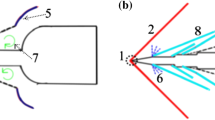Abstract
The Coanda effect has been introduced into lift generation designs. In this paper, a logarithmic spiral surface is introduced as a curvature shape to evaluate the development of jet flow along the Coanda curvature. Moreover, 2D computational fluid dynamics numerical simulation is adopted to measure velocity profile, jet width growth, maximum velocity decay, and surface static pressure along the curvature surface. A parametric study on the effect of varying exit jet heights on the Coanda effect is also presented. Results show that jet width grows proportionally along the curved surface, and the proportional decay of maximum velocity and surface pressure is lower than the atmospheric pressure. A wider exit jet height produces lower static pressure on the unmanned aerial vehicle surface and a slower maximum velocity decay. Overall parametric analysis of varying exit jet heights shows that the effective range of d/R is 0.1 to 0.14.
Similar content being viewed by others
References
H. Coanda, Device for deflecting a stream of elastic fluid projected into an elastic fluid, U.S. Patent, 2052869 (1936).
C. Lubert, On some recent applications of the Coanda effect to acoustics, Proceedings of Meetings on Acoustics, 11 (2010).
J. Kweder, C. C. Panther and J. E. Smith, Applications of circulation control, yesterday and today, International Journal of Engineering, 14 5 2010 411–429.
H. Coanda, Propelling device, U.S. Patent, 2108652 (1938).
I. Reba, Applications of the Coanda effect, Scientific American, 214 6 1966 84–92.
B. Saeed and G. B. Gratton, An approach to evaluate lift generated by an annular-Coanda-wing for vertical/short takeoff and landing applications, Proceedings of the Institution of Mechanical Engineers, Part G: Journal of Aerospace Engineering, 226 10 2012 1298–1314.
N. Mirkov and B. Rasuo, Numerical simulation of air jet attachment to convex walls and applications, Proceedings of International Congress of the Aeronautical Sciences, Nice, France (2010).
G. Hatton, Thrust generating apparatus, European Patent, 1863704 (2010).
J. L. Naudin, The GFS UAV project- A Coanda effect flying saucer tested by Jean-Louis Naudin, http://jlnlabs.online.fr/gfsuav/index.htm (2007).
Y. Noguchi, Two-dimensional turbulent jet on a combined all having step changes in wall curvature, Ph.D. Thesis, Department of Aeronautical and Mechanical Engineering, University of Salford, Manchester, United Kingdom (1985).
E. S. Levinsky and T. T. Yeh, Analytical and experimental investigation of circulation control by means of a turbulent Coanda jet, National Aeronautics and Space Administration, 2114 (1972).
M. Trancossi, An overview of scientific and technical literature on Coanda effect applied to nozzles, SAE Technical Paper, 2011-01-2591 (2011).
C. M. Poulsen, Augmented flow, An interesting method of fluid-flow augmentation with attractive possibilities, Flight Aeronautical Weekly, 1964 1946 174–175.
J. F. Morrison and D. G. Gregory-Smith, Calculation of an axisymmetric turbulent wall jet over a surface of convex curvature, International Journal of Heat and Fluid Flow, 5 3 1984 139–148.
H.S. Rew and S. O. Park, The curved wall jet over a circular cylinder before the interaction of two opposing curved wall jets, KSME Journal, 10 1 1996 86–93.
J. T. K. Ping, S. K. Ban, C. S. Tan, T. T. S. Peng and C. S. Ng, Preliminary design of vertical take-off and landing (VTOL) UAV with steerable vertical thrust effect, IEEE International Conference on Robotics, Automation and Mechatronics, Singapore (2010) 275–279.
A. Jr. Voedisch, Analytical investigation of the Coanda effect, Air Materiel Command Wright-Patterson Technical Report, ADA800399 (1947).
B. G. Newman, The deflexion of plane jets by adjacent boundaries-Coanda effect, Boundary Layer and Flow Control, 1 1961 232–264.
P. Bradshaw, Effects of streamline curvature on turbulent flow, Advisory Group for Aerospace Research and Development, Paris, France (1973).
J. A. Giles, A. P. Hays and R. A. Saywer, Turbulent wall jets on logarithmic spiral surfaces, The Aeronautical Quarterly, 17 1966 201–215.
K. Kamemoto, Investigation of turbulent wall jets over logarithmic spiral surfaces: 1st report, development of jets and similarity of velocity profile, Bulletin of JSME, 17 105 1974 335–342.
D. E. Guitton and B. G. Newman, Self-preserving turbulent wall jets over convex surfaces, Journal of Fluid Mechanics, 81 1 1977 155–185.
Wolfram Research, Inc., Logarithmic spiral — from Wolfram MathWorld, http://mathworld.wolfram.com/LogarithmicSpiral.html.
F. R. Menter, M. Kuntz and R. Langtry, Ten years of industrial experience with the SST turbulence model, Proceeding of the International Symposium on Turbulence, Heat and Mass Transfer, Antalya, Turkey (2003) 625–632.
R. C. Swanson, C. L. Rumsey and S. G. Anders, Aspects of numerical simulation of circulation control airfoils, Proceedings of the NASA/ONR Circulation Control Workshop, Hampton, Virginia, USA (2004) 227–273.
Author information
Authors and Affiliations
Corresponding author
Additional information
Recommended by Associate Editor Do Hyung Lee
CaiYin Gan received her bachelor’s degree from Universiti Tenaga Nasional, Malaysia in 2010. She is currently pursuing her Ph.D. degree at the Center for Advanced Mechatronics and Robotics in Universiti Tenaga Nasional, Malaysia.
Rights and permissions
About this article
Cite this article
Gan, C., Sahari, K.S.M. & Tan, C. Numerical investigation on Coanda flow over a logarithmic surface. J Mech Sci Technol 29, 2863–2869 (2015). https://doi.org/10.1007/s12206-015-0615-y
Received:
Revised:
Accepted:
Published:
Issue Date:
DOI: https://doi.org/10.1007/s12206-015-0615-y




